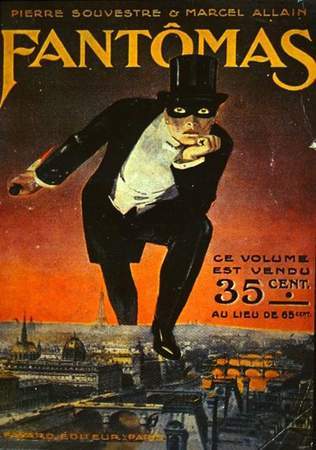Thirty years ago, I wandered into the screening room of the Museum of Modern Art in Manhattan. Several hours later I wandered out, in a daze, in a fever dream. The world looked different to me. What had happened in the interim: I'd seen the 1913 silent French serial Fantômas. It has haunted me ever since.
Fantômas -- the creation of writers Marcel Allain and Pierre Souvestre, then filmed by the incomparable Louis Feuillade -- was an assassin, a master of disguise, a figure of elegant terror (often depicted as striding the rooftops of Atget-era Paris with top hat, mask, and a bloody dagger in his right hand). He appeared, he disappeared, he killed for no reason. Inspector Juve of the police was always one step behind. You might capture Fantômas, put him in a cell on death row; but when the guillotine blade fell, the rolling head would belong to someone else, and Fantômas would be outside the walls. He was Batman and the Joker rolled into one, but decades before either, striking anonymous fear into the heart a city far more real and far more fantastic than the fictional Gotham.
The film I saw thirty years ago had awkward costumes, primitive plot contrivances, non-naturalistic acting. But it had (like its eponymous arch-fiend) the power to haunt. The world of Fantômas was another world, and to live in it, even for a few hours, was to sense a different city just the other side of the one in which we day-to-day live. As a consequence Fantômas has endured, a red and black thread weaving through the very fabric of the 20th century. Among the fans this pulp fiction villain has attracted over that span are such as Magritte and Juan Gris, who painted him; James Joyce, who coined the adjective 'enfantomastic;' Kurt Weill, who wrote the music for The Ballad of Fantômas; Julio Cortázar, who pitted Fantômas against the Multinational Vampires.
Over the past few decades, facilitated by the internet, we Friends of Fantômas have begun to find each other - there's an immigration lawyer in Vietnam, a professor in Alaska, a screenwriter in Hollywood (that would be me), a bookseller in San Francisco, a graphic artist, a journalist, an anesthesiologist, scores more. And we realized that this spring marks the 100th anniversary of the birth of the Lord of Terror. (He made his first appearance in print in February, 1911.)
To celebrate, we've worked to incite a series of birthday bashes -- an academic conference at Yale, several nights of fun at City Lights Books in San Francisco, a discussion at The New School in New York. But the centennial fun kicks of this Thursday, January 13, 7pm at the Billy Wilder Theater of the Hammer Museum right here in LA.
The Hammer Museum will be showing a beautiful newly-restored print of the 1913 Feuillade Fantômas serial Le Mort Qui Tue, with a live musical accompaniment by talented Mr. James Fearnley, whom you may better know as the accordion player in the Pogues. We'll follow that with a discussion with filmmaker and UCSD professor Jean-Pierre Gorin, Fantômas scholar Robin Walz, film critic and writer Ken Turan of the Los Angeles Times, moderated by yours truly. And we'll then adjourn to the Hammer Museum courtyard for a fitting birthday party.
I can't guarantee that this evening will change your life as profoundly and luminously as the one that introduced me to these realms thirty years ago. But it might. And what, I ask enfantomastically, have you got to lose?
Thanks for your time. Details here. Hope to see you.
